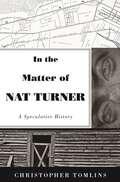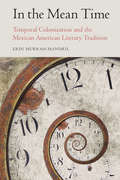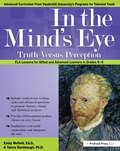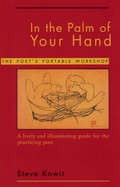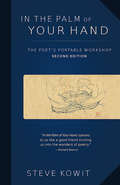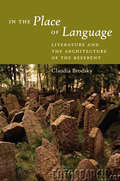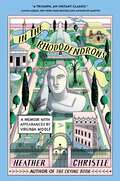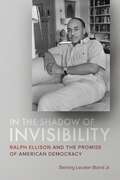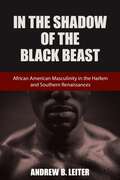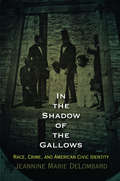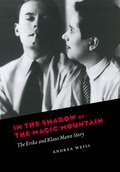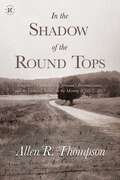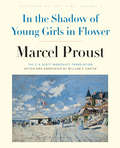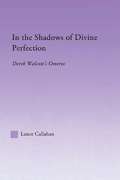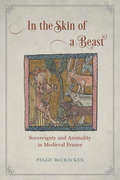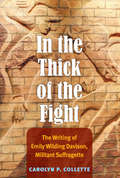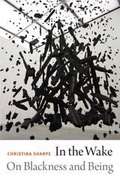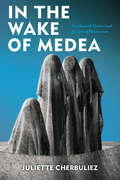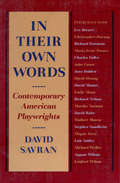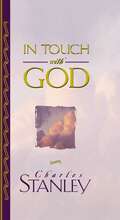- Table View
- List View
In the Matter of Nat Turner: A Speculative History
by Christopher TomlinsA bold new interpretation of Nat Turner and the slave rebellion that stunned the American SouthIn 1831 Virginia, Nat Turner led a band of Southampton County slaves in a rebellion that killed fifty-five whites, mostly women and children. After more than two months in hiding, Turner was captured, and quickly convicted and executed. In the Matter of Nat Turner penetrates the historical caricature of Turner as befuddled mystic and self-styled Baptist preacher to recover the haunting persona of this legendary American slave rebel, telling of his self-discovery and the dawning of his Christian faith, of an impossible task given to him by God, and of redemptive violence and profane retribution.Much about Turner remains unknown. His extraordinary account of his life and rebellion, given in chains as he awaited trial in jail, was written down by an opportunistic white attorney and sold as a pamphlet to cash in on Turner’s notoriety. But the enigmatic rebel leader had an immediate and broad impact on the American South, and his rebellion remains one of the most momentous episodes in American history. Christopher Tomlins provides a luminous account of Turner's intellectual development, religious cosmology, and motivations, and offers an original and incisive analysis of the Turner Rebellion itself and its impact on Virginia politics. Tomlins also undertakes a deeply critical examination of William Styron’s 1967 novel, The Confessions of Nat Turner, which restored Turner to the American consciousness in the era of civil rights, black power, and urban riots.A speculative history that recovers Turner from the few shards of evidence we have about his life, In the Matter of Nat Turner is also a unique speculation about the meaning and uses of history itself.
In the Mean Time: Temporal Colonization and the Mexican American Literary Tradition (Postwestern Horizons)
by Erin Murrah-MandrilThe 1848 Treaty of Guadalupe Hidalgo, which transferred more than a third of Mexico&’s territory to the United States, deferred full U.S. citizenship for Mexican Americans but promised, &“in the mean time,&” to protect their property and liberty. Erin Murrah-Mandril demonstrates that the U.S. government deployed a colonization of time in the Southwest to insure political and economic underdevelopment in the region and to justify excluding Mexican Americans from narratives of U.S. progress. In In the Mean Time, Murrah-Mandril contends that Mexican American authors challenged modern conceptions of empty, homogenous, linear, and progressive time to contest U.S. colonization. Taking a cue from Latina/o and borderlands spatial theories, Murrah-Mandril argues that time, like space, is a socially constructed, ideologically charged medium of power in the Southwest. In the Mean Time draws on literature, autobiography, political documents, and historical narratives composed between 1870 and 1940 to examine the way U.S. colonization altered time in the borderlands. Rather than reinforce the colonial time structure, early Mexican American authors exploited the internal contradictions of Manifest Destiny and U.S. progress to resist domination and situate themselves within the shifting political, economic, and historical present. Read as decolonial narratives, the Mexican American cultural productions examined in this book also offer a new way of understanding Latina/o literary history.
In the Mind's Eye: Truth Versus Perception, ELA Lessons for Gifted and Advanced Learners in Grades 6-8
by Emily Mofield Tamra StambaughWinner of the 2012 NAGC Curriculum Studies Award In the Mind's Eye: Truth Versus Perception invites students on a philosophical exploration of the themes of truth and perception. Lessons include a major emphasis on rigorous evidence-based discourse through the study of common themes and content-rich, challenging informational and fictional texts. This unit, developed by Vanderbilt University's Programs for Talented Youth and aligned to the Common Core State Standards (CCSS), applies concepts from Plato's "Allegory of the Cave" to guide students to discover how reality is presented and interpreted in fiction, nonfiction, art, and media. Students engage in activities such as Socratic seminars, literary analyses, skits, and art projects, and creative writing to understand differing perceptions of reality. Lessons include close readings with text-dependent questions, choice-based differentiated products, rubrics, formative assessments, and ELA tasks that require students to analyze texts for rhetorical features, literary elements, and themes through argument, explanatory, and prose-constructed writing. Ideal for pre-AP and honors courses, the unit features art from M.C. Escher and Vincent Van Gogh, short stories from Guy de Maupassant and Shirley Jackson, longer texts by Daniel Keyes and Ray Bradbury, and informational texts related to sociology, Nazi propaganda, and Christopher Columbus. This unit encourages students to translate learning to real-life contexts and problems by exploring themes of disillusionment, social deception, and the power of perception. Grades 6-8
In the Palm of Your Hand: A Poet's Portable Workshop
by Steve KowitAn illuminating and invaluable guide for beginners wary of modern poetry, as well as for more advanced students who want to sharpen their craft and write poems that expand their technical skills, excite their imaginations, and engage their deepest memories and concerns. Ideal for teachers who have been searching for a way to inspire students with a love for writing--and reading--contemporary poetry. It is a book about shaping your memories and passions, your pleasures, obsessions, dreams, secrets, and sorrows into the poems you have always wanted to write. If you long to create poetry that is magical and moving, this is the book you've been looking for. Here are chapters on the language and music of poetry, the art of revision, traditional and experimental techniques, and how to get your poetry started, perfected, and published. Not the least of the book's pleasures are model poems by many of the best contemporary poets, illuminating craft discussions, and the author's detailed suggestions for writing dozens of poems about your deepest and most passionate concerns.
In the Palm of Your Hand, Second Edition: A Poet's Portable Workshop
by Steve Kowit*Over 90,000 copies sold* Long an anchor text for college and junior college writing classes, this illuminating and invaluable guide has become a favorite for beginning poets and an ever-valuable reference for more advanced students who want to sharpen their craft, expand their technical skills, and engage their deepest memories and concerns.This edition adds Steve Kowit’s famous essay on poetics “The Mystique of the Difficult Poem,” in which he argues stirringly and forcefully that a poem need not be obscure to be great. Ideal for teachers who have been searching for a way to inspire students with a love for writing--and reading--contemporary poetry. It is a book about shaping your memories and passions, your pleasures, obsessions, dreams, secrets, and sorrows into the poems you have always wanted to write. If you long to create poetry that is magical and moving, this is the book you've been looking for. Here are chapters on the language and music of poetry, the art of revision, traditional and experimental techniques, and how to get your poetry started, perfected, and published. Not the least of the book's pleasures are model poems by many of the best contemporary poets, illuminating craft discussions, and the author's detailed suggestions for writing dozens of poems about your deepest and most passionate concerns.
In the Place of Language: Literature and the Architecture of the Referent
by Claudia BrodskyThe "place" in the title of Claudia Brodsky's remarkable new book is the intersection of language with building, the marking, for future reference, of material constructions in the world. The "referent" Brodsky describes is not something first found in nature and then named but a thing whose own origin joins language with materiality, a thing marked as it is made to begin with. In the Place of Language: Literature and the Architecture of the Referent develops a theory of the "referent" that is thus also a theory of the possibility of historical knowledge, one that undermines the conventional opposition of language to the real by theories of nominalism and materialism alike, no less than it confronts the mystical conflation of language with matter, whether under the aegis of the infinite reproducibility of the image or the identification of language with "Being."Challenging these equally naive views of language - as essentially immaterial or the only essential matter - Brodsky investigates the interaction of language with the material that literature represents. For literature, Brodsky argues, seeks no refuge from its own inherently iterable, discursive medium in dreams of a technologically-induced freedom from history or an ontological history of language-being. Instead it tells the complex story of historical referents constructed and forgotten, things built into the earth upon which history "takes place" and of which, in the course of history, all visible trace is temporarily effaced. Literature represents the making of history, the building and burial of the referent, the present world of its oblivion and the future of its unearthing, and it can do this because, unlike the historical referent, it literally takes no place, is not tied to any building or performance in space. For the same reason literature can reveal the historical nature of the making of meaning, demonstrating that the shaping and experience of the real, the marking of matter that constitutes historical referents, also defers knowledge of the real to a later date. Through close readings of central texts by Goethe, Plato, Kant, Heidegger, and Benjamin, redefined by the interrelationship of building and language they represent, In the Place of Language analyzes what remains of actions that attempt to take the place of language: the enduring, if intermittently obscured bases, of theoretical reflection itself.
In the Rhododendrons: A Memoir with Appearances by Virginia Woolf
by Heather ChristleFor readers of Also a Poet, Orwell&’s Roses, and My Autobiography Of Carson McCullers—as well as the legions of Virginia Woolf fanatics—the acclaimed poet and author of The Crying Book crafts a deeply moving, immersive, and lyrical hybrid memoir about her mother, Woolf, and the transformative power of writing. When Heather Christle realizes that she, her mother, and Virginia Woolf share a traumatic history, she begins to rewrite and intertwine each of their stories, in search of a more hopeful narrative and a future she can live with. On a recent visit to London's Kew Gardens, Christle&’s mother revealed details of a painful story from her past that took place there, under circumstances that strangely paralleled Heather's own sexual assault during a visit to London as a teenager. Her private, British mother&’s revelation—a rare burst of vulnerability in their strained relationship—propels Christle down a deep and destabilizing rabbit hole of investigation, as she both reads and wanders the streets of her mother's past, peeling back the layers of family mythologies, England&’s sanctioned historical narratives, and her own buried memories. Over the course of several trips to London, with and without her mother, she visits her family's "birthday hill" in Kew Gardens, the now-public homes of the Bloomsbury set, the archives of the British Library, and the backyard garden where Woolf wrote her final sentence. All the while, she finds that Woolf and her writings not only constantly seem to connect and overlap with her mother&’s story, but also that the author becomes a kind of vital intermediary: a sometimes confidante, sometimes mentor, sometimes distancing lens through which Christle can safely observe her mother and their experiences. Wide-ranging and prismatic, the fruit of an insatiably curious, delightfully brilliant mind, In the Rhododendrons is part memoir, part biography of Virginia Woolf, part reckoning with the things we cannot change and the ways we can completely transform, if we dare. This utterly original book will stir readers into new ways of seeing their own lives.
In the Shadow of Invisibility: Ralph Ellison and the Promise of American Democracy
by Sterling Lecater Bland Jr.With In the Shadow of Invisibility, Sterling Lecater Bland Jr. offers a long-overdue reconsideration of Ralph Ellison, examining the trajectory of his intellectual thought in relation to its resonances in twenty-first-century American culture. Bland charts Ellison’s evolving attitudes on several central topics including democracy, race, identity, social community, place, and political expression. This compelling new exploration of Ellison’s legacy stresses the perpetual need to reexamine the intersections of race, literature, and American culture, with particular attention to how the democratic principle has grown increasingly urgent in the nation’s ongoing, and often contentious, conversations about race. Arguing that Ellison saw racial and social identity as being inseparable from the nation’s past and its complicated history of racial anxiety, In the Shadow of Invisibility traces the growth and transformation of Ellison’s ideas across his life and work, from his early apprentice writing that culminated in his groundbreaking first novel, Invisible Man, through the posthumous publication of his unfinished second novel, Three Days before the Shooting . . . Focused on his mythic vision of the promise of America, this book firmly situates Ellison in the sociopolitical environments from which his ideas arose, with close consideration of his published writings, including his influential essays on literature and jazz, as well as his working notes and correspondence. Bland foregrounds Ellison’s thinking on the responsibilities of Black writers to examine democratic ideals, the legacies of slavery and Jim Crow, and the impacts of civil rights movements. Interweaving biography, history, and literary criticism, and drawing from extensive archival research, In the Shadow of Invisibility reveals the extent to which Ellison’s work exposes the contradictions inherent in American culture, arguing anew for the importance and immediacy of his writings in the broader context of American intellectual thought.
In the Shadow of the Black Beast: African American Masculinity in the Harlem and Southern Renaissances (Southern Literary Studies)
by Andrew B. LeiterAndrew B. Leiter presents the first book-length study of the sexually violent African American man, or "black beast," as a composite literary phenomenon. According to Leiter, the black beast theme served as a fundamental link between the Harlem and Southern Renaissances, with writers from both movements exploring its psychological, cultural, and social ramifications. Indeed, Leiter asserts that the two groups consciously engaged one another's work as they struggled to define roles for black masculinity in a society that viewed the black beast as the raison d'être for segregation.Leiter begins by tracing the nineteenth-century origins of the black beast image, and then provides close readings of eight writers who demonstrate the crucial impact anxieties about black masculinity and interracial sexuality had on the formation of American literary modernism. James Weldon Johnson's The Autobiography of an Ex-Colored Man, Walter White's The Fire in the Flint, George Schuyler's Black No More, William Faulkner's Light in August, Margaret Mitchell's Gone with the Wind, Allen Tate's The Fathers, Erskine Caldwell's Trouble in July, and Richard Wright's Native Son, as well as other works, provide strong evidence that perceptions of black male sexual violence shaped segregation, protest traditions, and the literature that arose from them.Leiter maintains that the environment of southern race relations -- which allowed such atrocities as the Atlanta riot of 1906, numerous lynchings, Virginia's Racial Integrity Act, and the Scottsboro trials -- influenced in part the development of both the Harlem and Southern Renaissances. While the black beast image had the most pernicious impact on African American individual and communal identities, he says the "threat" of black masculinity also shaped concepts of white national and communal identities, as well as white femininity and masculinity. In the Shadow of the Black Beast signals a fresh interpretation of a literary stereotype within its social and historical context.
In the Shadow of the Gallows
by Jeannine Marie DelombardFrom Puritan Execution Day rituals to gangsta rap, the black criminal has been an enduring presence in American culture. To understand why, Jeannine Marie DeLombard insists, we must set aside the lenses of pathology and persecution and instead view the African American felon from the far more revealing perspectives of publicity and personhood. When the Supreme Court declared in Dred Scott that African Americans have "no rights which the white man was bound to respect," it overlooked the right to due process, which ensured that black offenders--even slaves--appeared as persons in the eyes of the law. In the familiar account of African Americans' historical shift "from plantation to prison," we have forgotten how, for a century before the Civil War, state punishment affirmed black political membership in the breach, while a thriving popular crime literature provided early America's best-known models of individual black selfhood. Before there was the slave narrative, there was the criminal confession.Placing the black condemned at the forefront of the African American canon allows us to see how a later generation of enslaved activists--most notably, Frederick Douglass--could marshal the public presence and civic authority necessary to fashion themselves as eligible citizens. At the same time, in an era when abolitionists were charging Americans with the national crime of "manstealing," a racialized sense of culpability became equally central to white civic identity. What, for African Americans, is the legacy of a citizenship grounded in culpable personhood? For white Americans, must membership in a nation built on race slavery always betoken guilt? In the Shadow of the Gallows reads classics by J. Hector St. John de Crèvecoeur, Edgar Allan Poe, Frederick Douglass, Herman Melville, George Lippard, and Edward Everett Hale alongside execution sermons, criminal confessions, trial transcripts, philosophical treatises, and political polemics to address fundamental questions about race, responsibility, and American civic belonging.
In the Shadow of the Magic Mountain: The Erika and Klaus Mann Story
by Andrea WeissThomas Mann’s two eldest children, Erika and Klaus, were unconventional, rebellious, and fiercely devoted to each other. Empowered by their close bond, they espoused vehemently anti-Nazi views in a Europe swept up in fascism and were openly, even defiantly, gay in an age of secrecy and repression. Although their father’s fame has unfairly overshadowed their legacy, Erika and Klaus were serious authors, performance artists before the medium existed, and political visionaries whose searing essays and lectures are still relevant today. And, as Andrea Weiss reveals in this dual biography, their story offers a fascinating view of the literary and intellectual life, political turmoil, and shifting sexual mores of their times. In the Shadow of the Magic Mountain begins with an account of the make-believe world the Manns created together as children—an early sign of their talents as well as the intensity of their relationship. Weiss documents the lifelong artistic collaboration that followed, showing how, as the Nazis took power, Erika and Klaus infused their work with a shared sense of political commitment. Their views earned them exile, and after escaping Germany they eventually moved to the United States, where both served as members of the U. S. armed forces. Abroad, they enjoyed a wide circle of famous friends, including Andre Gide, Christopher Isherwood, Jean Cocteau, and W. H. Auden, whom Erika married in 1935. But the demands of life in exile, Klaus’s heroin addiction, and Erika’s new allegiance to their father strained their mutual devotion, and in 1949 Klaus committed suicide. Beautiful never-before-seen photographs illustrate Weiss’s riveting tale of two brave nonconformists whose dramatic lives open up new perspectives on the history of the twentieth century.
In the Shadow of the Magic Mountain: The Erika and Klaus Mann Story
by Andrea WeissA biography of Thomas Mann's two eldest children that provides intriguing insight into both their lives and the political and cultural shifts at the same time. Thomas Mann’s two eldest children, Erika and Klaus, were unconventional, rebellious, and fiercely devoted to each other. Empowered by their close bond, they espoused vehemently anti-Nazi views in a Europe swept up in fascism and were openly, even defiantly, gay in an age of secrecy and repression. Although their father’s fame has unfairly overshadowed their legacy, Erika and Klaus were serious authors, performance artists before the medium existed, and political visionaries whose searing essays and lectures are still relevant today. And, as Andrea Weiss reveals in this dual biography, their story offers a fascinating view of the literary and intellectual life, political turmoil, and shifting sexual mores of their times.In the Shadow of the Magic Mountain begins with an account of the make-believe world the Manns created together as children—an early sign of their talents as well as the intensity of their relationship. Weiss documents the lifelong artistic collaboration that followed, showing how, as the Nazis took power, Erika and Klaus infused their work with a shared sense of political commitment. Their views earned them exile, and after escaping Germany they eventually moved to the United States, where both served as members of the U.S. armed forces. Abroad, they enjoyed a wide circle of famous friends, including Andre Gide, Christopher Isherwood, Jean Cocteau, and W. H. Auden, whom Erika married in 1935. But the demands of life in exile, Klaus’s heroin addiction, and Erika’s new allegiance to their father strained their mutual devotion, and in 1949 Klaus committed suicide. Beautiful never-before-seen photographs illustrate Weiss’s riveting tale of two brave nonconformists whose dramatic lives open up new perspectives on the history of the twentieth century.
In the Shadow of the Round Tops: Longstreet's Countermarch, Johnston's Reconnaissance, and the Enduring Battles for the Memory of July 2, 1863
by Allen R. ThompsonExciting new research lifts much of the fog surrounding the Battle of Gettysburg and offers a glimpse into what happened on that fateful day—July 2, 1863.James Longstreet&’s countermarch and Samuel Johnston&’s morning reconnaissance are two of the most enigmatic events of the Battle of Gettysburg. Both have been viewed as major factors in the Confederacy&’s loss of the battle and, in turn, the war. Yet much of it lies shrouded in mystery. Though the battle is one of the most well-documented events in history, the vast majority of our knowledge comes from the words of the veterans and civilians who experienced it. Without action photography, video, or audio recordings, our primary window into what happened is the memory of those who were there. The story of the Battle of Gettysburg is simply the compilation of the memories of those who fought it. But memory is anything but objective. Recognizing the multitude of factors that affect human memory, In the Shadow of the Round Tops explores how the individual soldiers experienced, remembered, and wrote about the battle, and how those memories have created a cloud over James Longstreet&’s enigmatic countermarch and Samuel Johnston&’s infamous reconnaissance. Each soldier had a particular view of these historic events. Because many people saw part of the story, but no one saw all of it, each memory is a critical piece to the puzzle. By comparing the veterans&’ memories and sifting through the factors that affected each memory, the picture of the countermarch, reconnaissance, and the entire battle, comes into sharper focus.
In the Shadow of Young Girls in Flower
by William C. Carter Marcel ProustEdited and annotated by leading Proust scholar William Carter, In the Shadow of Young Girls in Flower is the second volume of one of the twentieth century's great literary triumphs.  It was this volume that won the Prix Goncourt in 1919, affirming Proust as a major literary figure and dramatically increasing his fame. Here the narrator whose childhood was reflected in Swann's Way moves further through childhood and into adolescence, as the author brilliantly examines themes of love and youth, in settings in Paris and by the sea in Normandy. The reader again encounters Swann, now married to his former mistress and largely fallen from high society, and meets for the first time several of Proust's most memorable characters: the handsome, dashing Robert de Saint-Loup, who will become the narrator's best friend; the enigmatic Albertine, leader of the "little band" of adolescent girls; the profoundly artistic Elstir, believed to be Proust's composite of Whistler, Monet, and other leading painters; and, making his unforgettable entrance near the end of the volume, the intense, indelible Baron de Charlus.  Permeated by the "bloom of youth" and its resonances in memories of love and friendship, In the Shadow of Young Girls in Flower takes readers into the heart of Proust's comic and poetic genius. As with Swann's Way, Carter uses C. K. Scott Moncrieff's beloved translation as the basis for this annotated and fully revised edition. Carter corrects long-standing errors in Scott Moncrieff's otherwise superlative translation, bringing it closer than ever to the spirit and style of Proust's original text--and reaching English readers in a way that the Pléiade annotations cannot. Insightful and accessible, Carter's edition of Marcel Proust's masterwork will be the go-to text for generations of readers seeking to understand Proust's remarkable bygone world.
In the Shadows of Divine Perfection: Derek Walcott's Omeros (Studies in Major Literary Authors #30)
by Lance CallahanIn the Shadows of Divine Perfection provides an examination of Derek Walcott's Omeros 1990)- the St. Lucian poet's longest work, and the piece that secured his Nobel Laureate-that reveals the deep-seated bond between the root narratives of ancient Greece to the cultural products and practices of the contemporary Caribbean. This book presents the first detailed reading of Walcott's highly controversial attempt to craft a Caribbean master narrative. This book also presents an overview of the poem's ideological orientation and a far-reaching critique of current postcolonial theory. Lance Callahan engages some of the most vexing problems of authenticity by reading Walcott's work alongside ancient Greek literature and culture.
In the Skin of a Beast: Sovereignty and Animality in Medieval France
by Peggy McCrackenIn medieval literature, when humans and animals meet—whether as friends or foes—issues of mastery and submission are often at stake. In the Skin of a Beast shows how the concept of sovereignty comes to the fore in such narratives, reflecting larger concerns about relations of authority and dominion at play in both human-animal and human-human interactions. Peggy McCracken discusses a range of literary texts and images from medieval France, including romances in which animal skins appear in symbolic displays of power, fictional explorations of the wolf’s desire for human domestication, and tales of women and snakes converging in a representation of territorial claims and noble status. These works reveal that the qualities traditionally used to define sovereignty—lineage and gender among them—are in fact mobile and contingent. In medieval literary texts, as McCracken demonstrates, human dominion over animals is a disputed model for sovereign relations among people: it justifies exploitation even as it mandates protection and care, and it depends on reiterations of human-animal difference that paradoxically expose the tenuous nature of human exceptionalism.
In the Thick of the Fight: The Writing of Emily Wilding Davison, Militant Suffragette
by Carolyn P. ColletteOne of the most memorable images of the British women's suffrage movement occurred on June 4, Derby Day, 1913. As the field of horses approached a turning at Epsom, militant suffragette Emily Wilding Davison ducked out from under the railing and ran onto the track, reaching for the bridle of the King's horse, and was killed in the collision. While her death transformed her into a heroine, it all but erased her identity. To identify what impelled Davison to suffer multiple imprisonments, to experience the torture of force-feedings and the insults of hostile members of the crowds who came to hear her speak, Carolyn P. Collette explores a largely ignored source--the writing to which Davison dedicated so much time and effort during the years from 1908 to 1913. Davison's writing is an implicit apologia for why she lived the life of a militant suffragette and where she continually revisits and restates the principles that guided her: that woman suffrage was necessary to improve the lives of men, women, and children; that the freedom and justice women sought was sanctioned by God and unjustly withheld by humans whose opposition constituted a tyranny that had to be opposed; and that the evolution of human progress demanded that women become fully equal citizens of their nation in every respect-- politically, economically, and culturally. In the Thick of the Fight makes available for the first time the archive of published and unpublished writings of Emily Wilding Davison. Collette reorients both scholarly and public attention away from a single, defining event to the complexity of Davison's contributions to modern feminist discourse, giving the reader a sense of the vibrancy and diversity of Davison's suffrage writings.
In the Wake: On Blackness and Being
by Christina SharpeIn this original and trenchant work, Christina Sharpe interrogates literary, visual, cinematic, and quotidian representations of Black life that comprise what she calls the "orthography of the wake." Activating multiple registers of "wake"--the path behind a ship, keeping watch with the dead, coming to consciousness--Sharpe illustrates how Black lives are swept up and animated by the afterlives of slavery, and she delineates what survives despite such insistent violence and negation. Initiating and describing a theory and method of reading the metaphors and materiality of "the wake," "the ship," "the hold," and "the weather," Sharpe shows how the sign of the slave ship marks and haunts contemporary Black life in the diaspora and how the specter of the hold produces conditions of containment, regulation, and punishment, but also something in excess of them. In the weather, Sharpe situates anti-Blackness and white supremacy as the total climate that produces premature Black death as normative. Formulating the wake and "wake work" as sites of artistic production, resistance, consciousness, and possibility for living in diaspora, In the Wake offers a way forward.
In the Wake of Medea: Neoclassical Theater and the Arts of Destruction
by Juliette CherbuliezIn the Wake of Medea examines the violence of seventeenth-century French political dramas. French tragedy has traditionally been taken to be a passionless, cerebral genre that refused all forms of violence. This book explores the rhetorical, literary, and performance strategies through which violence persists, contextualizing it in a longer literary and philosophical history from Ovid to Pasolini.The mythological figure of Medea, foreigner who massacres her brother, murders kings, burns down Corinth, and kills her own children, exemplifies the persistence of violence in literature and art. A refugee who is welcomed yet feared, who confirms the social while threatening its integrity, Medea offers an alternative to western philosophy’s ethical paradigm of Antigone. The Medean presence, Cherbuliez shows, offers a model of radically persistent and disruptive outsiderness, both for classical theater and for its wake in literary theory.In the Wake of Medea explores a range of artistic strategies integrating violence into drama, from rhetorical devices like ekphrasis to dramaturgical mechanisms like machinery, all of which involve temporal disruption. The full range of this Medean presence is explored in treatments of the character Medea and in works figuratively invoking a Medean presence, from the well-known tragedies of Racine and Corneille through a range of other neoclassical political theater, including spectacular machine plays, Neo-Stoic parables, didactic Christian theater. In the Wake of Medea recognizes the violence within these tragedies to explain why violence remains so integral to literature and arts today.
In the Year of the Boar and Jackie Robinson: Instructional Guides For Literature (The World Around Us)
by Bette Bao Lord Marc SimontNIMAC-sourced textbook
In Their Own Words
by Jeanette BeerIn Their Own Words examines early medieval history-writing through quotation practices in five works, each in some way the first of its kind. Nithard's Historiae de dissensionibus filiorum Ludovici Pii is extraordinary for its quotation of vernacular oaths, the first recorded piece of French. The Gesta Francorum is the first eye-witness account of the First Crusade. Geoffrey of Villehardouin's La Conquête de Constantinople, written by a leader and negotiator of the Fourth Crusade, and Robert de Clari's La Conquête de Constantinople, written by a common soldier in the same crusade, are the first extant French prose histories. Li Fet des Romains, a translation and compilation of all the classical texts about Julius Caesar (including Caesar's own Gallic Wars) that were known in the thirteenth century, is the first work of ancient historiography and the first biography to appear in French.Jeanette Beer's work bridges the divide between the study of vernacular and Latin writing, providing new evidence that the linguistic cultures were not isolated from each other. Her examination of quotation practices in early medieval histories illuminates the relationship between classical and contemporary influences in the formative period of history-writing in the West.
In Their Own Words
by David SavranIncludes: Lee Breuer, Christopher Durang, Richard Foreman, Maria Irene Fornes, Charles Fuller, John Guare, Joan Holden, David Henry Hwang, David Mamet, Emily Mann, Richard Nelson, Marsha Norman, David Rabe, Wallace Shawn, Stephen Sondheim, Megan Terry, Luis Valdez, Michael Weller, August Wilson and Lanford Wilson.
In Touch With God: Develop A Closer Relationship With God (In Touch Study Ser. #Vol. 19)
by Charles F. StanleyPastor and bestselling author Charles Stanley brings you closer to the Lord in this unique book filled with inspirational Scriptures as well as thoughts and prayers from the author. "In Touch With God" will help you know God's heart on a variety of topics, including forgiveness, His guidance, relationships, Spirit-filled living, Christian character, adversity, and God's plan for your life.
In Transition: Young Adult Literature and Transgender Representation (Children's Literature Association Series)
by Emily CorbettThe first book-length work of its kind, In Transition: Young Adult Literature and Transgender Representation examines the shift in the young adult book market towards increased representation of transgender characters and authors. Through a comprehensive exploration of historical conventions, genres, character diversity, and ideologies of trans representation, Emily Corbett traces the roots of trans literature from its beginnings in a cisgender-dominated publishing world to the recent rise in trans creators, characters, and implied readers. Corbett describes how trans-ness was initially perceived as an issue to be overcome by cisgender authors and highlights the ways in which the market has changed.Through careful analysis of texts that have until now received little scholarly attention, Corbett weaves together different theoretical approaches and fields of study to provide a map of the textual and cultural histories of this twenty-first-century publishing phenomenon. Focusing on trans authorship, authentic storytelling, and intersectional diversity, this book charts changing public attitudes, the YA book market, and the unique sociocultural moment in which these books are published. In Transition contributes new perspectives on the intersections of adolescence and trans-ness and sheds light on a dynamic subset of YA literature that has yet to receive sustained analysis.
